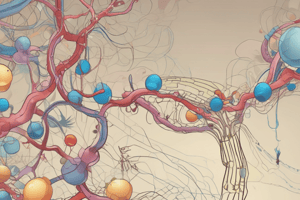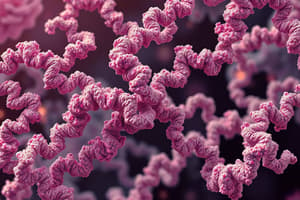Podcast
Questions and Answers
What is the primary function of hormones?
What is the primary function of hormones?
What is the term for the process of a protein losing its shape and function?
What is the term for the process of a protein losing its shape and function?
denaturation
All proteins are fibrous in nature.
All proteins are fibrous in nature.
False
There are approximately __________ types of amino acids that comprise all proteins.
There are approximately __________ types of amino acids that comprise all proteins.
Signup and view all the answers
What is the role of enzymes in living cells?
What is the role of enzymes in living cells?
Signup and view all the answers
Match the following proteins with their characteristics:
Match the following proteins with their characteristics:
Signup and view all the answers
All proteins have the same molecular weight.
All proteins have the same molecular weight.
Signup and view all the answers
What is the term for the molecules that bind to enzymes?
What is the term for the molecules that bind to enzymes?
Signup and view all the answers
What type of enzymes are responsible for breaking down substrates?
What type of enzymes are responsible for breaking down substrates?
Signup and view all the answers
All amino acids are essential for human health and must be obtained through diet.
All amino acids are essential for human health and must be obtained through diet.
Signup and view all the answers
What components make up the basic structure of an amino acid?
What components make up the basic structure of an amino acid?
Signup and view all the answers
Salivary amylase is an enzyme that hydrolyzes ______, a component of starch.
Salivary amylase is an enzyme that hydrolyzes ______, a component of starch.
Signup and view all the answers
Match the following amino acids with their nature:
Match the following amino acids with their nature:
Signup and view all the answers
Which of the following amino acids is nonpolar?
Which of the following amino acids is nonpolar?
Signup and view all the answers
Proline is an exception to the standard structure of amino acids because its amino group is separate from the side chain.
Proline is an exception to the standard structure of amino acids because its amino group is separate from the side chain.
Signup and view all the answers
How many common amino acids are present in proteins?
How many common amino acids are present in proteins?
Signup and view all the answers
Study Notes
Proteins
- Proteins are among the most abundant organic molecules in living systems and exhibit the widest variety of functions among macromolecules.
- Functions of proteins include structural, regulatory, transport, storage, protective, enzymatic, and toxic roles.
- Each cell may contain thousands of distinct proteins, each serving a unique function based on its specific amino acid sequence.
- Proteins are polymers made up of amino acids organized in a linear sequence, exhibiting diverse shapes and molecular weights.
- Globular proteins (e.g., hemoglobin) are typically more rounded, while fibrous proteins (e.g., collagen in skin) have elongated structures.
- Protein shape is crucial for its function; many types of chemical bonds help maintain this shape.
- Changes in temperature, pH, or chemicals can permanently alter a protein’s shape, resulting in loss of function (denaturation).
- All proteins are composed of arrangements of 20 standard amino acids, plus two rare amino acids: selenocysteine and pyrrolysine.
- Hormones, often small proteins or steroids secreted by endocrine cells, play key roles in regulating physiological processes (e.g., insulin regulates blood glucose levels).
- Enzymes are complex or conjugated proteins produced by living cells that act as catalysts in biochemical reactions, such as digestion.
- Each enzyme is substrate-specific, facilitating breakdown (catabolic enzymes) or synthesis (anabolic enzymes) processes.
Amino Acids
- Amino acids are the monomers that make up proteins, each containing a central carbon (α carbon), an amino group (NH2), a carboxyl group (COOH), a hydrogen atom, and a unique R group.
- The term "amino acid" reflects the presence of both an amino and a carboxyl group in their structure.
- There are 20 common amino acids, with nine being essential for humans, as they cannot be synthesized by the body and must be obtained through diet.
- The R group determines the characteristics of each amino acid, categorizing them as acidic, basic, polar, or nonpolar.
- Nonpolar amino acids (e.g., valine, methionine, alanine) are hydrophobic, while polar amino acids (e.g., serine, threonine, cysteine) are hydrophilic.
- Lysine and arginine possess positively charged side chains, classifying them as basic amino acids.
- Proline is atypical, as its R group forms a ring structure linked to the amino group, differing from standard amino acid composition.
Studying That Suits You
Use AI to generate personalized quizzes and flashcards to suit your learning preferences.
Description
Learn about the diverse range of functions of proteins in living systems, including structural, regulatory, contractile, and protective roles. Discover how proteins vary in structure and function in each cell.




